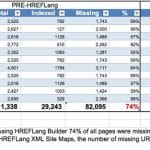Who Should Manage Hreflang?
April 7, 2018
HREFLang XML results in 200% Increase in Traffic to South American Sites
May 1, 2018HREFLang Builder Wins Best SEO Tool
HREFBuilder recently won the Best SEO Tool category at the European Search Awards and wanted to share some of the key innovations that helped us with the win:

Innovation 1 – Mapping and Managing Large Scale Websites
For most websites using available scripts or WordPress plugins to add HREFLang tags to the page work just fine. However, for larger sites and companies with many language versions, on-page tags add too much code and their complex URL structures often require significant logic for scripts and 100+ hours of coding to integrate.
Consulting with hundreds of global clients, Back Azimuth has identified and developed logic to accommodate 600+ different pattern match variations of country language statements. Our user interface allows self-help users to select from 280 of the most common variations during setup. All other tools force you to use standard structures that do not exist in most enterprise companies, making these tools unusable.
Innovation 2 – Ability to Match different language URL’s
A recent survey on HREFLang challenges indicated the #1 reason companies struggle with implementing HREFLang on their sites, requiring them to code it in-house and/or only submit top-level categories, is due to the inability of commercial tools to map localized URL’s. HREFLang Builder has developed multiple methods of matching different language URLs.
- Method 1 – Translated Directories/URL’s – the user selects one or multiple local directory names/URL’s and assigns them to a master classification.
- Method 2 – SKU, Product Code, Parameter – Sites that use a unique product parameter in the URL representing a SKU or a category word can map variables across languages to all equivalent pages.
- Method 3 – Local/Global ID Mapping – We upload a data table from the client’s backend mapping using a global product ID and the local product IDs. During page validation, we grab the ID token from the metadata and assign in the database. The ID’s are mapped and parsed out into HREFLang alternate blocks in the XML site maps. This spans different URL structures and languages very efficiently.
Innovation 3 – Change Monitoring
The most recent innovation allows a user to upload a before and after rank report for each market and receive a “change report.” By comparing the country and language code of the pages ranking before implementation and them after, the user can quickly see when and how many URL’s are swapped for the correct version. This is not currently any other way other than a manual review to determine how many pages have converted and those that have not.
Innovation 4 – Ongoing Management
Other than incorrect language ID’s and missing alternative pages, the biggest mistake companies make is take a one and done approach to HREFLang. The site is always changing pages for many reasons. For many companies, the HREFLang XML is not current a week later. We have added a number of options to keep them current.
Innovation 1 – Period Cron Updates – the user can set the frequency of refresh and the source and we will rebuild the files dynamically at those intervals. We can FTP to a server, email or save to Dropbox the files for security check and uploading by the client.
Innovation 2 – Change Monitoring – unfortunately XML site maps as a source is like whack a mole. One week it is there and the next it is not as well as the number of URL’s included. After each update, the HREFLang Builder emails an update with the before and after a number of URL’s and errors for each market as well as any increase or decrease in markets.
Learn more about our HREFLang XML Sitemap Builder

